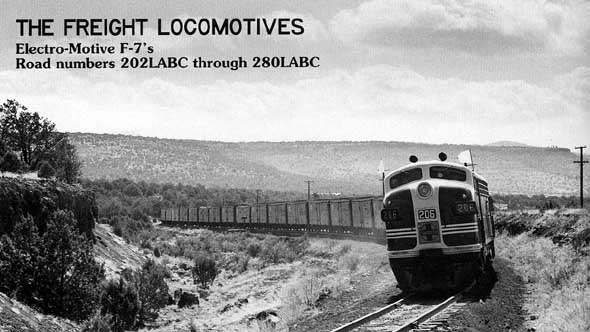 F7 206 leads a PFX train through Arizona shortly after delivery in the summer of 1949. The 200 class locomotives finally finished the job started by the FT's - total dieselization of the Santa Fe. - John McCall Collection. |
|
Deliveries of Santa Fe’s freight F7’s began in June of 1949 with locomotive 202LABC and units procured through 258LABC were all essentially identical with 36 D/B fans, EMD’s own horizontal slit stainless steel grilles (hereafter referred to as horizontal slit grilles"), and standard-sized F7 fuel tanks with full skirting over the top part of the fuel tank and battery box. Units 259LABC through 268LABC were similar to the early units except they were delivered without the stainless steel grilles. They had "chicken wire" screens in the upper carbody openings that was similar to the arrangement found on the early F3 production. I have heard for years that they gave up their grilles to early units of the 16 class that were built without stainless steel grilles. If this is true, EMD must have changed production from horizontal slit grilles to vertical slit "Farr Air" type stainless steel grilles (hereafter referred to as "vertical slit grilles") about that time. Almost all the 16 class were fitted with vertical slit grilles although some units, including 31L and 35L (and probably others) are known to have carried the horizontal slit grilles a least for a while. For some unknown reason, locomotives 269LABC and 268LABC were later fitted with stainless steel grilles while the 260LABC through 267LABC were never retrofitted with them spending their entire careers with "chicken wire" screens. Unit 259L had horizontal slit grilles retrofitted initially but ended up with vertical slit grilles. I have photos of it with both types of grilles. Perhaps its grilles were accidentally swapped with another unit during a shop visit since it is known that such shop errors happened fairly frequently. Boosters 254A through 266A carried a steam generator and all four units of these locomotive sets were equipped with steam and signal lines so they could be used on troop trains passenger specials or such other passenger trains as the need arose. Freight F7’s 269LABC through 280LABC were late production F7’s and featured 48" D/B fans, vertical slit grilles, vertical slit filter openings between the portholes, air piping on the roof and wider fuel tanks with abbreviated skirting, features usually associated with F9’s rather F7’s. The 200 class underwent very little renumberings over the years with the exception of units 251BC through 256BC being renumbered to 281LA through 286LA in 1951. These units were renumbered back to their original numbers in 1953. Units 241L, 236C, 257C, 235C, 212L and 268C were renumbered to 101L through 106L for a few months in 1972 for use as lead units with road slugs on unit potash trains south of Clovis, but reverted back to their original numbers when CF-7’s were assigned to that service. Must of the 200 class were delivered in the standard blue/yellow freight livery with the "catwhisker" nose emblem similar to that applied to the FT s (see sidebar article on painting). No 200’s are known to have received the solid blue experimental paint scheme of 1951/52 as they were probably too new for any to need repainting at that time. However, the "catwhisker" nose emblem was replaced with the passenger-style emblem on all units by the mid-1950’s. As with the FT’s, the addition of various grab irons, wrecking lugs, radio antennas, nose MU doors, and removal of fuel tank skirts gave them a distinctive Santa Fe appearance. Like the FTs, individual 200 class units were operated together indiscriminately by 1960. The earlier practice of operating all four units in seriatim as a single locomotive was abandoned in favor of assembling lashups of whatever size was required from available units at terminals. The 200’s along with the FT ‘s formed the backbone of the Santa Fe’s mainline freight motive power roster through the decade of the 1950’s. Newer locomotives of GP20, SD24 and RSD-15 types pushed the FTs aside for the most part by 1960 but the 200’s were still first class mainline power until the SD45’s began arriving in 1965. These hood units bumped many of the 200 s to secondary branchline freight service where they replaced GP7’s that were transferred to yard service to replace aging yard switchers, especially Baldwins and FM’s that were being retired. Assigned to Cleburne for maintenance where they replaced the departed FT’s, 200 s wene a common sight on the Santa Fe into the mid-1970’s. Their numbers were dwindling however as more and more A-units were rebuilt into CF-7’s and B-units were retired. After the last A-unit was retired in 1978, some B-units were operational until the last one, F7B 262B was retired on October 31, 1980. The last active A-unit I saw was the 252C on July 2, 1977 at Amarillo along with a B-unit had come in from Lubbock on a local |







